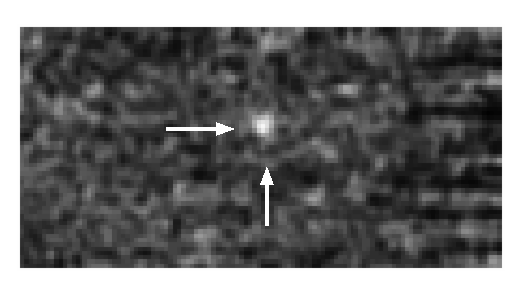 CU26 Imaged at 20 microns with the MAX camera.
CU26 Imaged at 20 microns with the MAX camera.
|
Thermal Observations of Centaur 1997 CU26
David Jewitt and
Paul Kalas
Astrophysical Journal Letters, 1998, 499, L103-106.
|
|---|
Abstract
We combine new measurements of thermal emission from the Centaur 1997 CU26 with
published optical photometry to determine the geometric albedo
(0.045 +/- 0.010) and effective diameter (302 +/- 30 km). While model-dependent,
these values clearly show that 1997 CU26 is the largest of the known Centaurs,
and that its surface is very dark.
In a Nutshell
The fraction of the sunlight reflected from a planetary body is known as the
albedo.
The optical brightness of an object viewed by reflected light is proportional
to the cross-sectional area of the object multiplied by the albedo.
The infrared brightness of the same object is proportional to the cross-sectional
area multiplied by (1 - albedo). Why? Because the infrared radiation is sunlight
that was absorbed by the object and re-radiated as heat. The fraction of the sunlight
that is absorbed is (1 - albedo).
Therefore, from measurements of the optical and infrared radiation, we can
determine both cross-section (or size) and albedo. Two observations give two
constraints on two unknowns.
The problem is...how to get the thermal data? Distant planetary objects are cold, weak sources of heat. We used a sensitive thermal camera ( "MAX") to image CU26 at the 3.8-m UKIRT telescope on Mauna Kea:
 CU26 Imaged at 20 microns with the MAX camera.
CU26 Imaged at 20 microns with the MAX camera.
In fact, the thermal emission depends in detail on the surface temperature distribution on the body, which is itself affected by rotation and the thermal parameters of the body. Therefore, a unique solution demands more data than is typically available (isn't that always the way?). Nevertheless, we can get a good idea of what is going on by comparing the optical and thermal IR data. Our model results are summarised graphically.
With CU26, we can show that, regardless of the specific temperature distribution, the only allowable solutions give albedos that are very small (few percent) and diameters that are large (300 km more).
Therefore, our main result is that CU26 is large and dark. In fact, it is the largest known Centaur, entirely comparable in properties to the Kuiper Belt objects beyond it.
FULL AP J LETT PAPER (Postscript)
Last updated March 1998